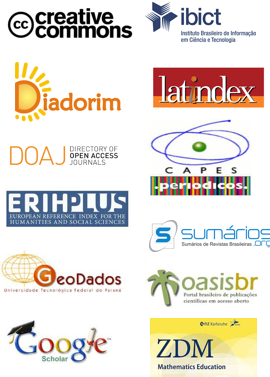Propostas de Atividades com Tabelas em Livros Didáticos de Matemática dos Anos Iniciais do Ensino Fundamental do Brasil e do Quebec
DOI:
https://doi.org/10.17921/2176-5634.2021v14n1p14-25Resumo
Resumo
O livro didático é uma das principais fontes de consulta dos professores no ensino de estatística. Esse artigo analisa atividades envolvendo tabelas apresentadas nos livros didáticos de Matemática, dos anos iniciais do Ensino Fundamental do Brasil e do Quebec/CA. Nossas análises se fundamentaram em seis categorias: tipo de representação (quadro, banco de dados ou tabela); função da tabela; habilidade explorada; tipo de tabela (simples ou dupla entrada); tipo de variável; representação dos elementos fundamentais da tabela. Os resultados revelam que, em todos os anos de escolarização, podemos encontrar os três tipos de representação, sendo a maior frequência de tabelas em ambos os lugares de publicação. Além disso, a maioria delas é utilizada como objeto de estudo, indicando uma mudança recente de foco nos livros brasileiros, que priorizavam atividades na quais as tabelas eram pretexto para outros conceitos serem abordados. Observamos, entretanto, uma ênfase em interpretar e completar tabelas já estruturadas. Infelizmente, muitas tabelas não apresentam a fonte, principalmente nos livros do Quebec. A ausência de contextos reais e significativos não contribui efetivamente para a aprendizagem Estatística pelos alunos.
Palavras-chave: Livros Didáticos. Ensino de Estatística. Tabelas. Anos Iniciais
Abstract
Textbooks are one of the main sources of consultation for teaching statistics. This article analyzes activities involving tables presented in Primary School Mathematics textbooks from Brazil and from Quebec - CA. Our analysis were based on six categories: type of representation (rectangular configuration, database or table); table function; explored skill; table type (single or double entry); type of variable; representation of the fundamental elements of the table. The results show that in all years of schooling we can find the three types of representation, with the highest frequency of tables in both places of publication. Most of them are used as an object of study, indicating a recent change of focus in Brazilian books that prioritized activities in which tables were a pretext for other concepts to be addressed. However, we still observe an emphasis on interpreting and completing tables already structured. Unfortunately, many tables do not present their source, especially in Quebec textbooks. The absence of real data and significant contexts effectively does not contribute to the students' significant learning of Statistics.
Keyword: Textbook. Teaching of Statistics. Tables. Primary School


